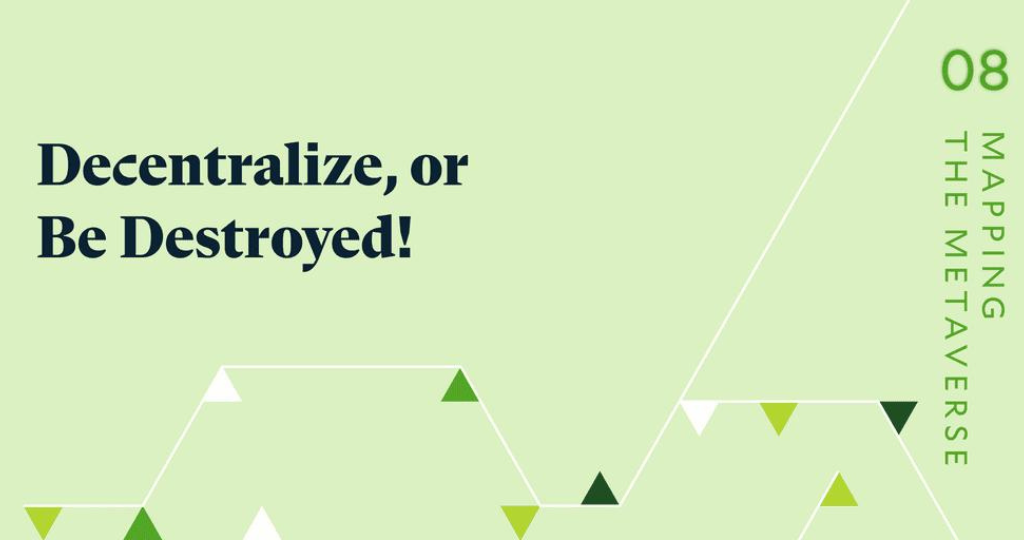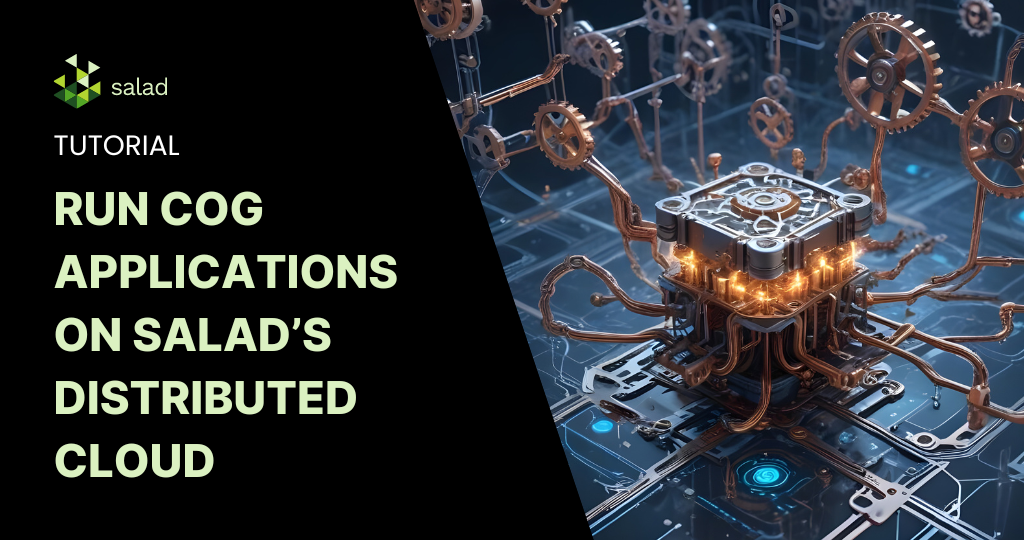The opinions and commentary expressed herein are those of the author, and do not necessarily reflect the views of everyone at Salad. We accept a diversity of viewpoints, flavors, and spices.
In our #MappingtheMetaverse summer series, we explored a world where video games are eternal, people power the Internet, and you can get paid to hatch baby unicorns. Just a few months later, the Metaverse is no longer fiction. Game developers are making hefty profits by allowing users to conjure its heart-stuff. Household names like Facebook have sacrificed brand cache to develop its infrastructure.
Venture capitalist Matthew Ball calls the Metaverse the “newest macro-goal of the world’s tech giants.” Legacy enterprises have already begun a hardware arms race to determine who will plug us in when the Internet goes metastatic. Over the next decade, we’ll see which companies survive the leap into a new dimension.
If our last transmission seemed spare on allusions to the almighty ‘verse, it’s because this moment must be properly contextualized. There’s a timeline schism coming. Unless we band together as a distributed counter-current, centralized forces might cast our Metaverse in the mold of today’s Internet.
…since the Street does not really exist—it’s just a computer-graphics protocol written down on a piece of paper somewhere—none of these things is being physically built. They are, rather, pieces of software, made available to the public over the worldwide fiber-optics network. When Hiro goes into the Metaverse and looks down the Street and sees buildings and electric signs stretching off into the darkness, disappearing over the curve of the globe, he is actually staring at the graphic representations—the user interfaces—of a myriad different pieces of software that have been engineered by major corporations.
— Neal Stephenson, Snow Crash
IN THE BEGINNING
Let’s spin a yarn of the early days. On January 1, 1983, a loose affiliation of academic researchers published the TCP/IP protocol, the simple vocabulary of exchange that still underpins all networked computer communications. Decades after military researchers had established ARPANet, those pioneers helped the world access tools that had been long reserved for siloed government applications.
It was a victory for free information—but it was hard to see the point unless you moved in those circles. Keep in mind that pagers were king. Email was so new it was hyphenated. By the time Snow Crash hit shelves in 1992, the Internet remained a mostly anonymous web of interconnected pages. Yet Neil Stephenson saw what it represented.
His seminal work gave us the very notion of the Metaverse we now anticipate. Stephenson’s hackers featured among the O.G. cyberpunk cliques, stalwarts of free exchange to its most lurid extremes. They nourished the Metaverse with katana combat, digitized dive bars, and rock venues that would make Party Royale blush. It was a decentralized Holy Land, where anyone could create anything, without the intervention of a third party.
THE BOMB DOTCOM
The years that followed introduced millions of people to unbridled information flow. Despite the limitations of the “read-only web,” (where you could only write or read data and content served from static HTML files) the early Internet became a boomtown. Fortunes were made and unmade on the changing whims of the world’s first webizens.
Ecommerce sites rode the dotcom boom to vaunted positions like Major Kong on rewind. Then, America Online was not a repository of “mom news,” but a titanic service provider that held together a continent. For the zoomers among us, that distant era also furnished a once-humble bookseller with enough riches to stargaze at point blank range (and produce history’s biggest divorce settlement).
Like any Wild West town, it wasn’t long before robber-barons ran out the competition.
As it exists today, the Internet is a fiefdom in thrall to a select few corporations. The corporate victors of Web 2.0 have become more concerned with profit than with preserving the freedom promised by the early web. We surf at the behest of monolithic cloud providers, and we communicate under the watchful eye of the platforms. Old Sonora is no more.
FREE-TO-PLAY PLATFORMERS
The majority of web applications have a short life cycle; few see the mass adoption necessary to make ongoing development worthwhile. Platforms are a different beast altogether. These are apps that have grown into closed systems with the power to affect the Internet at large.
Over the last decade, Silicon Valley social media giants have claimed unforeseen control of the web on the strength of their utility. Handy features have become the chaos emeralds by which they bind us, and their broad reach has made them so entrenched that most people see them as necessary pillars of the Internet. As developers at companies like Facebook, Google, and Amazon continuously integrated their product with more third-party services and tools, proprietary features empowered a handful of brands to become sole overseers of some of the world’s most profitable web ecosystems.
That vantage allowed them to leverage mobile and cloud technologies in ways no one else could. Most platforms now maintain their own colossal infrastructures—or else lord over other enterprises atop mountains of gigabytes. Their data centers are dragon’s hoards, and their fiber networks the interlarded tendrils of their market share.
You can’t argue that their success is undeserved—after all, Facebook, Google, and Amazon are each responsible for volumes of research that helped to revolutionize the web. But we’ve already seen what they’re willing to do with the scepter. Are these the companies we want in charge when the Internet starts pouring out of our glasses?
A TANGLED WEB WE WEAVE
In our first decades online, individuals helped to produce the purest distillations of the Internet’s foundational ideals. While early pioneers turned bits into bullion, Web 1.0’s most eager participants sought to answer time-worn questions of ownership, form, and self-expression.
Peer-to-peer networks like Limewire and Napster probed the boundaries of intellectual property law. The emo confessionals of LiveJournal and MySpace set the tone for their social media successors. Places like Geocities allowed certified lunatics to post “totally true” accounts of cryptid sightings for the aghast delight of eight year-olds everywhere. Without their excesses we would not have the vocabulary to answer the turmoil of today—or the perspective to ask necessary questions.
Web 2.0’s legacy is loss. For every gift the “social web” gave us, we gave away something even more valuable. Individuals traded privacy for connectivity, businesses abandoned autonomy for exposure, and sovereignty was sacrificed on the altar of convenience. And like the old saying goes, “If they’re giving it away free, you’re the product.”
WE(B) THE PEOPLE
With all credit due to the universities and government scientists who created the Internet, you might say it truly belongs to the people feeding it data. Nearly every call for decentralization harkens back to the example of the peer-to-peer communities that helped shape Web 1.0.
Individuals are the authors and arbiters of their lives; they should accordingly own their data, practice free expression, and benefit from unrestricted access to information. We were the authors of modern information. We will return to that role as nodes of a distributed future—because this might be our last chance to restore the peer-to-peer foundations of the web.
Decentralization isn’t just about finding future-proof infrastructure, nor is it solely about rejecting the efforts of a militant Thinkpol. It’s a simultaneous transformation that encompasses a structural decoupling from conventional cloud services and a spiritual divorce from hegemonic platforms. The economic influence of the leading tech companies has given them an unchallenged right to dictate the course of web development, web infrastructure, and—unless we act now—networked creativity.
GIG BUSINESS
Salad believes it is possible to decrease the reliance on centralized solutions by supporting alternative compute applications. Our engineers are building workload-agnostic infrastructure that will allow us to orchestrate medical research workloads, or share bandwidth to facilitate human communication.
As we add new computesharing opportunities to the Salad recipe, thousands of individuals will help us to rival the centralized cloud with affordable, people-powered alternatives. Distributed services like ours will enable individuals to not only make use of new technologies, but facilitate their ongoing development.
Gaming companies like Roblox and Epic Games have already leveraged emergent technologies to democratize access to creative tools. Their players are weaving the fabric of the Metaverse using zero-skill applications powered by machine learning and artificial intelligence. As legacy titans like Facebook and Microsoft break orbit to pursue the same goal, it’s up to us to make sure they play nice with the others who are giving individuals their due.
Salad will bridge the gap between tomorrow’s creatives and these budding metaverse economies. Today you can purchase V-Bucks and Robux with the power of your PC. In the future, you’ll be able to propagate your favorite metaverse experiences using the same compute resources. Hardware from the physical world will spark a digital cosmos—and continue to offer meaningful participatory value to its intrepid explorers.



